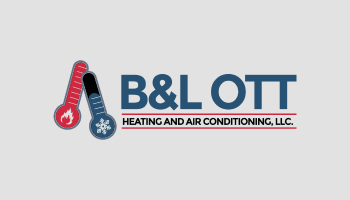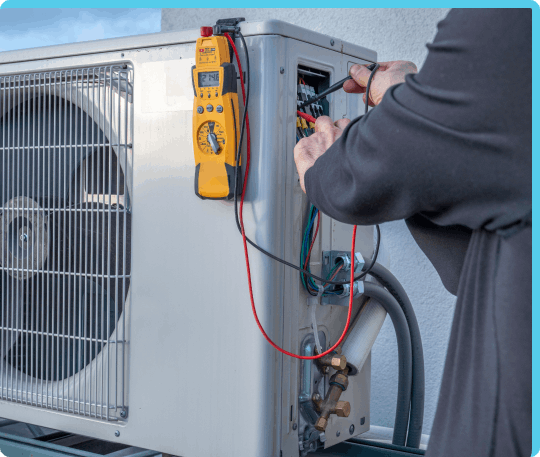Leaks are a clear sign that there is something wrong with your water heater. Leaks should be fixed as soon as possible. If you don’t correct the issue in a timely manner, it will only get worse. We highly recommend hiring a trained professional like B&L Ott. However, it is also helpful for you to understand the types of issues your B&L Ott technician will be looking for. Check out the basic information below.
Is It Dangerous to Have a Leaking Water Heater?
When it comes to leaking water heaters, the issue can be fairly harmless or it can be dangerous. Some leaks can be easily cleaned up while others can damage your home. Then some issues can be even more dangerous to your home and family. It is important to understand what you are dealing with so you can keep your family safe and minimize the damage to your home.
How to Fix a Leaking Water Heater
Many different variables can cause your water heater to leak. These reasons include age, poor installation, poor maintenance, loose valves, high pressure in the tank, and more. With this in mind, if you aren’t familiar with water heaters it can be tricky to determine what the issue is or know how to fix it. Fortunately, your B&L Ott technician will know what signs to look for to determine the source of the leak.
Safety Precautions and Finding The Leak Source
First, you will want to start generally by taking safety measures and performing some general tests to find out if the issue is specifically with the water heater or if it could be an outside source.
Check the Water Meter
If you notice higher water bills, or constantly hear water running, you could have a leak somewhere in your water line.
Step 1
A good first step is to check your water meter. Make sure water is not running either inside or outside your house. The water meter is usually located near the curb of your home or in some cases, your basement. Look for a concrete box marked “water” or call your water supplier for help. Next, check the leak indicator. If the needle is moving, there may be an issue with your plumbing somewhere. Even if the valve is not moving, taking readings at different times (an hour or two apart) can help you determine the general source of the leak.
Step 2
If the water meter determines you have a leak, the next step is to determine if the leak is inside or outside your home. Find the main water valve for your home and shut it off. This is usually in the basement. It can also be in the garage on the other side of the wall from your outdoor faucet. Again, make sure there is no water being used around your home. Then check the leak indicator. If it does not move, the leak is somewhere inside your house. If it does not move, the leak is somewhere outside your house.
Once you determine what line of pipes is leaking you can start narrowing down exactly where the leak is. Check out this video for more guidance.
Shut Off The Power
Next, you should shut off the power to your water heater to ensure safety for both yourself and your family. Interacting with water and electricity is extremely dangerous. If you are not confident in your ability to work with electricity, contact your electrician for help. According to the Spruce, “Electric water heaters are high-voltage (240-volt) appliances that are dangerous to work with when the power is on.”
Step 1
First, locate the main electrical panel. This is typically found in your basement. It is usually a large grey metal box. If you can not find it consult your home inspection report or call your local electrical company. There should be the main circuit breaker as well as multiple branches. The main one controls all electricity flowing into your home. The branch breakers that control the electricity flowing to certain sections of your home.
Step 2
Shut off the electricity flowing to your water heater by flipping the appropriate breaker to “OFF.
It is a good idea to leave the power to your water heater off until a B&L Ott technician makes it to your home.
Shut Off The Water
If anything is going to be touched, removed, or changed on your water heater, You also want to ensure that the water to the water heater is shut off.
Step 1
Go to your water heater and locate the cold water valve. This can look like a small wheel or it can be a lever. It is usually located on a pipe above the tank of the water heater.
Step 2
Turn the valve clockwise until the valve is closed. If it is a lever, pull it until the lever is 90 degrees from the open position.
By taking precautions to turn off the water and power supply to your water heater, you ensure safety and help avoid further damage.
Pinpoint The Exact Issue
Once safety precautions have been taken and general checks have been performed, it is time to move on to the parts of your water heater.
The Cold Water Inlet and Hot Water Outlet Connections
There are a variety of different issues that can occur with the cold water inlet and the hot water outlet connections. Typically, if you notice water on top of your water heater this may be the source of the leak. Here are some common issues.
Loose or Corroded Connections
If the cold water inlet or hot water outlet is loose or corroded, they can cause a leak. If this is the case, you will likely be able to see physical damage or water leaking out of the pipe. Contact the professionals at B&L Ott for a water heater repair.
Rainwater
If you have a gas water heater, under the right conditions, rainwater could be seeping in through the exhaust vent. If it rained at your house recently, this might be no cause for alarm. However, you still may want to call on the professionals at B&L Ott so you can ensure the components of your water heater are in working order.
Condensation
If a large amount of hot water is drawn from the tank at one time and then refills with cold water, condensation can occur. Generally, this occurs with smaller water heaters in small rooms with poor air flow. Usually, this is not a cause for alarm, but if the issue is constant, you should talk to B&L Ott to ensure the issue isn’t more serious.
Combustion Material
Combustion material can also spew out of the vent and collect on top of your tank. This isn’t always visible, but if you see it you should turn off your water heater and call B&L Ott. It is also a good idea to have a carbon monoxide detector near your water heater to ensure your family will be safe.
The Temperature & Pressure Relief Valve
One of the safety features on your water heater is the temperature and pressure relief valve. This valve is responsible for releasing water and steam from inside the tank so your system doesn’t explode. This can make it a little tricky to determine if the valve is actually leaking or if it is simply doing its job. However, if you discover that this valve is the source of the leak, it likely needs to be replaced. B&L Ott will happily help you accomplish this. Here are some common reasons why temperature & pressure relief valves leak.
Excess Water Pressure
If the temperature and pressure inside the tank get too high, the water will seek a way out. This can cause the temperature and pressure relief valve to leak.
Corrosion
If the spring inside the valve rusts or becomes covered with minerals, a leak will likely occur. This means the valve needs to be replaced.
Age
Over time, any machine, simple or complex, will experience wear-and-tear. If the valve is old and leaky, it is time to replace it.
Not Completely Closed
If the valve is not completely closed, it will likely leak. Make sure the valve is completely closed. This may take a bit of muscle.
The Drain Valve
A drain valve is responsible for holding all of the water in the tank. It is usually made of either plastic or metal and is used to drain the water heater when necessary. However, if there is an issue with this part, it can lead to a leak. It is important that you don’t let a problem like this unchecked. If the valve fails, your water heater could flood your basement. Trying to replace this valve yourself has the potential to burn you or flood your basement. With this in mind, it is better to call on the professionals at B&L Ott to ensure you don’t end up with bigger problems.
The Internal Tank
If you see water under your water heater, this is a good sign that there is an issue with your internal tank. This is one of the most common reasons for a water heater leak. Internal tank leaks are definitely not an issue you should try to fix on your own. It is important to call a licensed professional like B&L Ott. Many times, if this is the issue, your water heater likely needs to be replaced. This issue usually occurs due to corrosion caused by water-sediment buildup over the years.
Repair vs. Replace
Depending on what the issue is once you pinpoint the problem, you will have to determine if you want to repair or if you want to replace your system. There are multiple aspects to consider when trying to determine if you should repair or replace your system. This includes age, price of repairing your system, how many repairs it has needed in the past few years, and if the heater has been able to supply enough hot water.
If your system is a decade old or nearing this age, it may be time to replace it. Additionally, if the price of repairing your water heater is over half the price of a new one, installing a new one makes sense. When a water heater needs multiple repairs in a short period of time, this is a sign it is nearing a total breakdown. You should also ask yourself if your water heater can efficiently meet the demand for hot water. If your water heater struggles to heat enough water for your family, this is yet another reason to consider a replacement. If you need assistance determining which choice to make, the professionals at B&L Ott can help.
How to Repair a Leaking Water Heater
Once you finally pinpoint what part of your water heater is experiencing issues and have decided that you should repair rather than replace, you can move on to repairing your water heater. Some repairs are simple while others require a professional touch. Below you will find instructions for solving some of the simpler issues. If your water heater has a more complicated issue, B&L Ott can help you ensure the issue is fixed properly.
Cold Water Inlet and Hot Water Outlet Leaks
If your cold water inlet is dripping, all you may have to do is tighten the nut near the handle. Find an appropriately-sized wrench and tighten the nut. If the leak stops, congratulations, you solved the issue. However, you should still keep an eye on it to ensure that this was indeed the issue. If the leak gets worse, you may need to completely replace the in-line valve. If the leak continues, look into other potential issues.
Another potential issue in this area is a leaking joint. This issue could be a loose connection or stripped threaded nipple. This type of repair is more complicated and generally calls for a professional.
How to Replace Flex Lines
Temperature & Pressure Relief Valve Leaks
If your temperature and pressure relief valve is leaking, usually this is a sign that the valve needs to be replaced completely. Whether or not you can do so yourself depends on your skill level and experience.
Replacing a Temperature and Pressure Relief Valve
- Turn off the gas or electricity to your water heater. (See Shut Off Power section above.)
- Close the cold water cutoff valve.
- Drain the tank by opening the drain valve. Open the pressure relief valve to relieve pressure in the tank.
- Remove the overflow pipe from the pressure relief valve. (You may have to cut it off if it has been glued or soldered.
- Unscrew the old pressure relief valve by using a pipe wrench.
- On the new valve, wrap Teflon tape around the threads. Screw it on tight while orienting the overflow pipe opening away from the tank.
- Attach the relief valve drain pipe by wrapping Teflon tape around the threads. If you need to replace the drain pipe, be sure to use piping and glue that are rated for hot water.
- Reopen the cold water cutoff and check for leaks.
Other Temperature and Pressure Relief Valve Leaks
If you have already replaced the temperature and pressure relief valve and it continues to leak, there may be another underlying problem with your water heater. For instance, if there is too much pressure built up in the tank, the temperature and pressure relief valve will still continue to do its job and try to relieve the pressure. However, if there is excess pressure in the tank, the water will likely leak out of the temperature and pressure relief valve.
If this is the case, the fix becomes more complex. An expansion tank may need to be installed somewhere on the plumbing system. It is best to rely on a certified technician from B&L Ott. They have enough experience to be able to pinpoint the issue and ensure your water heater receives the proper fix.
Drain Valve Leaks
Replacing the drain valve on your water heater is another repair you should look to the professionals for. This is because, if something goes wrong, you could end up with water leaking into your house. It is also important to get the correct valve that matches your current one. Here is a general overview of the steps your B&L Ott technician will take to replace your drain valve if necessary.
- Turn off the power or gas.
- Turn off the water supply.
- Connect a hose to the drain and lead the other end of the hose outside.
- Drain the water heater tank.
- Remove the old drain valve.
- Install the new drain valve.
- Turn the water back on.
- Turn the power or gas back on.
- Check for leaks.
Explosions
Water heaters heat water. When water gets hot it expands. This increases the pressure in the tank. If the pressure within your water heater’s tank gets too high, there is the potential for it to explode.Water heaters have a temperature and pressure relief valve to help protect against excess amounts of pressure. However, if the temperature on your water heater is set too high and too much pressure builds up, your water heater can explode.
Be careful not to set the temperature on your water heater too high. According to the Center for Disease Control and Prevention,“Water heater thermostats should be set at about 120ºF (49ºC) for safety and to save 18% of the energy used at 140ºF (60ºC).” If you think the pressure within your water tank is too high, talk to a certified technician from B&L Ott to ensure your water heater is safe and working properly.
Broken Heating Element
Water and electricity don’t mix well and can be very dangerous. If there is water near the electric components of your water heater, you need to be extremely careful that you don’t get electrocuted. If you experience this type of issue, turn off the power supply to your water heater as well as the water. Then drain your water tank before touching and replacing any parts. You should also run hot water in your sink before returning power to your water heater. This way you can help prevent any further damage to the heating element.
Bad Water
If you have a rusty pipe, the water in your water heater can absorb this rust as well as other bacteria. This rust, chemicals, and bacteria can be harmful to your family. It is a good idea to inspect your water heater regularly to help protect your family from this problem.
Damage to Home and Belongings
Finally, one of the most common threats hot water leaks present is damage to your property. Water leaks can damage the walls, floors, foundation, and other belongings near your water heater. Moisture in the area can also lead to issues such as mold and mildew. If you notice a leak, clean it up thoroughly as soon as possible. Just make sure the area is safe to be in first. You should also monitor the area after a leak for mold and mildew.
What If My Hot Water Can’t Be Fixed?
When all is said and done, if you find out your water heater cannot be fixed, you will need to look for a replacement. There are multiple aspects you should consider when doing so. You will find these aspects below.
Fuel Source
Most homes are already set up to run appliances with a specific fuel source. This can include electricity, gas, propane, etc. While it is possible to convert your fuel source, you will likely find it more convenient and less expensive to purchase a water heater that runs on the fuel source your home is already set up for.
Type of Heater
There are also multiple types of water heaters. This includes storage tanks, tankless, point-of-use, and mobile home water heaters. Most homes use the storage tank models, but if your home has specific needs, be sure to get the right type of system.
Capacity
Every family uses different amounts of hot water. It is important to get the right size so you can ensure your family has enough hot water. Be sure to figure out how much hot water your household uses on average. You can find more information on the U.S. Department of Energy’s website here:
Dimensions
Some houses are tight on space. If this applies to your home, dimensions are another aspect you should pay attention to. You don’t want to buy a water heater only to find out it won’t fit.





